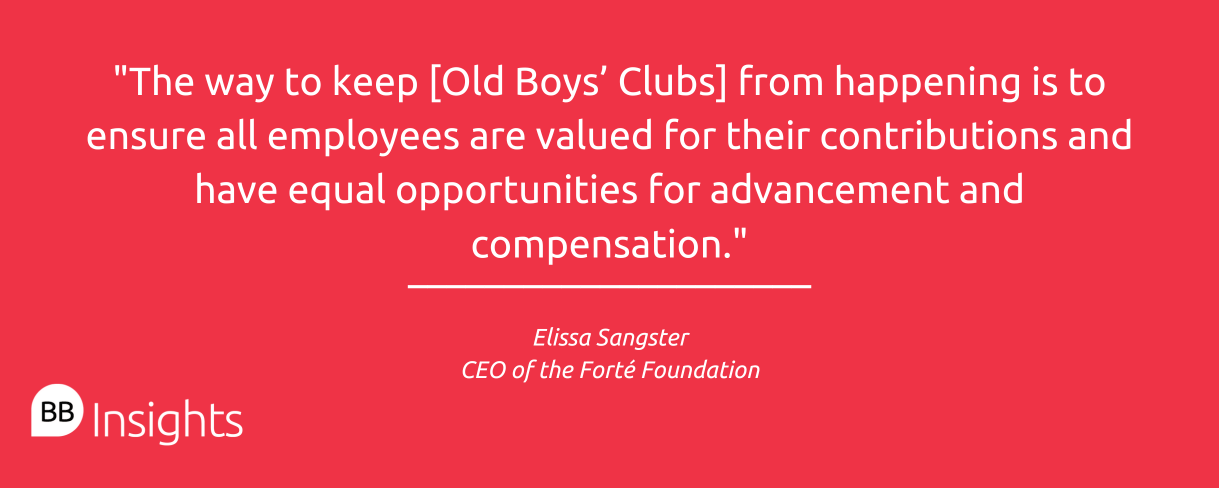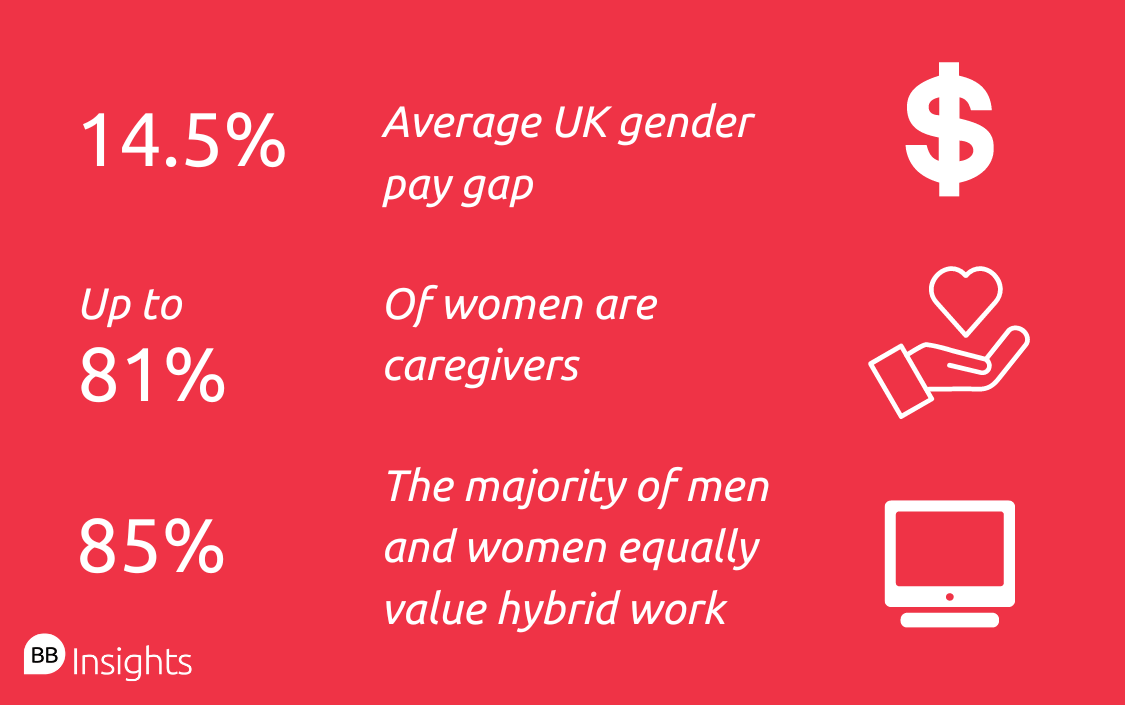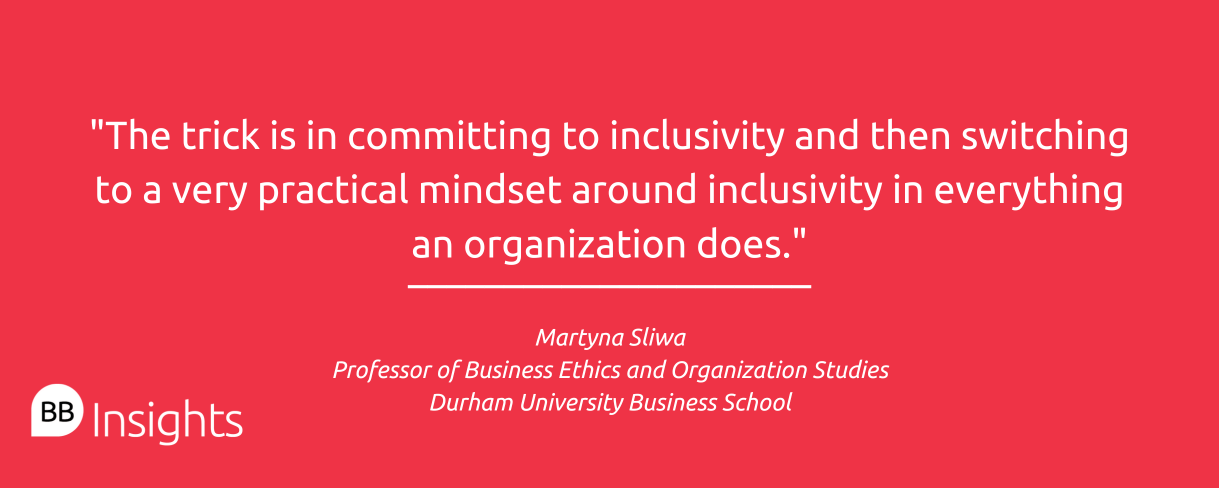If navigating systemic inequalities wasn’t difficult enough, with the gender pay gap widening among UK investment banks, female employees in the Sexism and the City inquiry also cited bullying, inappropriate behavior, and being sidelined after maternity leave.
The case is a painful reminder of the slow progress made since the viral #MeToo movement on social media in 2017, which amplified the voices of women affected by sexual harassment.
Sexism in the workplace may comprise overt actions such as disregarding women’s ideas, speaking over them in meetings, or relegating women and female colleagues to undesirable stereotypes. Yet it can also encompass more covert discrimination, such as the gender pay gap or promotion inequalities.
Women in finance and business have finally said, enough is enough. BusinessBecause spoke to two diversity experts to find out what actions businesses can take to tackle sexism in the workplace.
1. Dismantling ‘Old Boys’ Clubs’
While social work activities such as golf, soccer, or simply a pint at the pub are valid forms of maintaining relationships and connections in the workplace, these forums have the potential to become male-dominated.
Elissa Sangster is CEO of the Forté Foundation. Forté is a non-profit focused on achieving gender parity at all levels of business and in business school.
“No one forms ‘Old Boys’ Clubs’ on purpose,” she explains.
While many female employees enjoy social activities as much as their male counterparts, if such events take place at unsocial hours for women or are not geared towards women’s interests, these events may see an unintentional dwindling of female attendees.
Especially since up to 81% of caregivers are women and spend almost 50% more time providing care than males.
Workplace social events might just be considered a bit of fun, but such activities are key moments for building affinity with colleagues and senior managers.
A Harvard Business School study found that when employees have more in-person interactions with management, they are more likely to be promoted. The study linked this finding as a possible explanation for the gender gap in promotions in one firm.
“The way to keep [Old Boys’ Clubs] from happening is to ensure all employees are valued for their contributions and have equal opportunities for advancement and compensation,” explains Elissa.
This could mean involving female employees in the committees that create social events, gaining their perspective on suitable times to hold events.
Many companies are dismantling the forming of these clubs by creating formal sponsorship and mentoring programs, such as KPMG’s IT’s Her Future and the Accenture FeMale Mentoring program.
“Without mentoring, sponsorship and a formal plan for advancement, women are left to twist in the wind, with no clear direction on how to get to the next level,” says Elissa.
Sometimes, if a company doesn’t offer the necessary support and career advancement, this can result in women voting with their feet by finding a new role.
Research from the Forté Foundation found that women, particularly underrepresented minority women, are far more likely to leave a company because environment and culture weren’t a fit and they do not see an opportunity for advancement.

2. Fostering a supportive work culture
It’s all well and good that businesses take action to prevent sexism from happening but when, or if, it does, systems need to be in place for women to voice their concerns to senior management.
Martyna Sliwa is a professor of Business Ethics and Organization Studies at Durham University Business School. She is also vice chair of the British Academy of Management for Equality, Diversity, and Inclusion.
“Openly appreciating and acting upon concerns shared by employees helps build a culture in which people feel safe sharing concerns,” explains Martyna.
This means that managers need to improve some key skill areas to be able to manage and address concerns raised by women.
“[Business] leaders—regardless of their gender—can contribute to fostering such a culture through actively developing and using skills such as empathy and self-reflexivity, and through being courageous in showing their own vulnerability,” she says.
There is no excuse for male managers feeling unequipped to tackle issues of sexism experienced by females. Male ally groups can offer a starting point for understanding and empathizing with such issues and support other men to feel comfortable in speaking to management about their fellow employees.
Martyna points out three important ways that business leaders can contribute to a supportive work environment.
Firstly, clearly communicating to all employees that the organization wants to improve in certain areas. Secondly, explaining that employees’ experiences at work matter, and finally, outlining that sharing concerns is valued, she says.

3. Signing up for diversity charters and pay gap reporting
For a long time, diversity and gender pay gap disparities lurked somewhere underneath the surface. Everyone knew these inequalities were happening but with little data to back up their stories, women felt unempowered to speak out.
While a far-cry away from closing the gender pay gap or reaching parity in diversity, more and more businesses are signing up for diversity charters and gender pay gap reporting. In fact, in some countries, such as the UK, gender pay gap reporting is mandatory among public, private, and voluntary sector organizations.
“Making both internal and external commitments to diversity helps to create a virtuous circle to provide equitable opportunities for all.
“It also lets potential candidates know you are serious about diversity, which is increasingly important to younger generations, and helps companies to recruit a diverse workforce,” says Elissa.
A recent report in the UK found that companies such as British Airways, Jaguar Land Rover, and Amazon Services were the worst gender pay gap offenders.
Overall, the average gender pay gap in the UK stands at 14.5%. To put it simply, women are on average paid just 91p for every £1 a man earns.
Even Hollywood stars are not immune to disparities in pay. The actress Olivia Colman recently said she would be paid considerably more if her name was ‘Oliver’.
But now that the unsavory news is out, what can companies do next?
“Making commitments is not enough. You must demonstrate you are acting and making progress by being transparent on your diversity metrics, including how you ensure equal pay and promotion opportunities for everyone in your workplace,” warns Elissa.

4. Being conscious of how in-office attendance rules impact women
JP Morgan, Boeing, and UPS are among some of the most high-profile companies to mandate five-day in office attendance.
The KMPG CEO Outlook survey showed that 87% of global leaders are considering how financial rewards and promotion opportunities could be tied to future office attendance.
However, it’s important to be aware that compulsory office attendance can impact people differently.
For working mothers balancing looking after their children with work, the flexibility that hybrid or remote work allows for can bring great benefits and works toward levelling the playing field between men and women.
This is not to say that men don’t also value flexibility, especially those who share caregiving responsibilities with their partners.
In fact, according to research from the Forté Foundation, 85% of all respondents stated that the hybrid format is their ideal work environment.
“There are a lot of gender stereotypes when it comes to workplace flexibility. The truth is that the majority of men and women equally value flexibility at work,” says Elissa from Forté.
There are some nuances that are important to bear in mind, however.
“Women are less likely to prefer a fully in-person or a structured hybrid environment, where the employer sets the days of the week employees are required to be in the office. More often women prefer fully remote or flex hybrid, where they choose the days they work from home,” she adds.
Martyna from Durham University advises that businesses should consider their operational needs when making decisions about office attendance.
“The first step is to reflect on what these needs really are: are employees more productive when working from home or in the office? Can technology be utilized better to contribute to greater operational effectiveness? Are employees needed in the office every day or are they needed on specific days to ensure that colleagues see each other face-to-face?”
There is clearly no one-size-fits-all approach but it’s important for businesses to strike a good balance between operational needs and the needs of different employees.
5. Defining what a gender-inclusive workplace culture looks like
Even if all the steps above are followed, organizations still need to define what it means to foster a gender inclusive workplace culture. This isn’t just about setting a standard and then moving on—it’s about continually monitoring the culture, using employee feedback, and creating listening groups to review potential issues.
“Sometimes, we can all act in exclusionary ways without realizing it or engage in certain working practices without realizing that they lead to exclusionary outcomes.
“The trick is in committing to inclusivity and then switching to a very practical mindset around inclusivity in everything an organization does,” says Martyna.
For this reason, there are diversity and inclusion (DEI) coaches who can provide workplace training or review gender equality issues related to new policies.
Sexism in the business world is deeply entrenched. This doesn’t mean that there is no hope of solving the issue, it just means that there is no quick fix as businesses, senior managers, and employees need to work together to continually review processes that contribute to unequal treatment in the workforce.
BB Insights explores the latest research and trends from the business school classroom, drawing on the expertise of world-leading professors to inspire and inform current and future leaders.







